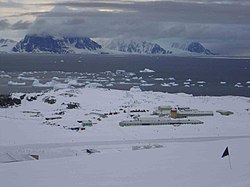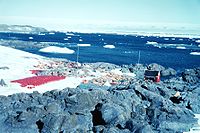Adelaide Island
| Adelaide Island | |
 Rothera on Adelaide Island | |
|---|---|
| Location | |
| Location: | 67°15’0"S, 68°30’0"W |
| Area: | 1,800 square miles |
| Highest point: | Mount Gaudry, 7,595 feet |
| Data | |
| Population: | around 100 |
Adelaide Island is a large, mainly ice-covered island, 75 miles long and 20 miles wide, lying at the north side of Marguerite Bay off the west coast of the Graham Land in the British Antarctic Territory. The Ginger Islands lie off the southern end of the island.
The island is the site of Rothera, the British Antarctic Survey base which serves as the territory's capital.
History

Adelaide Island was discovered in 1832 by a British expedition under John Biscoe. The island was first surveyed by the French Antarctic Expedition (1908–1910) under Jean-Baptiste Charcot.
The source of the island's name is unknown. British Antarctic Survey records state that Charcot named the island "Adelie Land" after the huge number of Adelie penguins that lived on its coast (the penguins being named after the wife of Dumont d'Urville). This in turn was turned into Adelaide Island by the British Graham Land Expedition (1934–37). It has also been supposed that the island was in fact named by Biscoe himself for Queen Adelaide of the United Kingdom.
The Island has two bases on it. The old Adelaide Island base (also known as Base T) was set up by the Falkland Islands Dependencies Survey, which became the British Antarctic Survey. The Base was closed due to an unstable skiway and operations were moved to the new Rothera Research Station during 1976-77; this base remains open. The old BAS base was transferred to the Chilean authorities in 1984, when it was renamed Teniente Luis Carvajal Villaroel Antarctic Base. The station was then used as a summer only station by the Chileans. However the skiway, and 'ramp' to the station from the plateau have all become so unstable, that the Chilean Air Force have ceased operating there. The Chilean Navy has visited the station almost every summer to ensure it is in good keeping. BAS employees also visit the station during the winter when access from the plateau is easier.
Due to the length of time that it has been inhabited the island is well mapped by Antarctic standards.